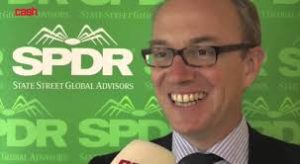
Fixed income exchange-traded funds listed in Europe gathered three quarters of the total ETF inflows in the region last month as traditional managers look to enter the market.
Antoine Lesné, head of SPDR ETF strategy & research EMEA at State Street Global Advisors, said at a briefing last week that fixed income flows into European ETFs last month were $6.7bn (€5.9bn), out of a total of $8.9bn.
Lesné said at the briefing: “There has been a good start to the year for ETF flows and one of the best for fixed income. Investors favoured sovereign over corporate risk.”
SSGA’S flash flows report for European ETFs for January said all fixed income sectors saw positive flows. The report said: “Government was the main driver, gathering $4.3bn last month and continuing the trend we saw through 2018.”
Flows were also evenly spread between investment grade and high-yield, which gathered $586m and $438m respectively.
Hector McNeil, co-chief executive of HANetf, Europe’s first independent ‘white-label’ Ucits ETF platform, said in an email that fixed income has traditionally lagged the growth of equity strategies in the passive and ETF space. However, there has been a considerable increase in new products which have increased assets under management.
“Alongside classic beta, smart beta and active strategies have emerged and added value to the ETF world, none more so than for fixed income, where it has had a positive effects on returns,” he added.”
McNeil continued that classic bond indexes based on market capitalisation do not work so well for investors as they could get exposure to high yielding, riskier bond issuers.
“Eventually active ETFs will be the largest segment in fixed income over time,” he said. “At HANetf we are having a significant number of white label ETF discussions with traditional fixed income asset managers looking to enter the ETF space.”
Last month Tabula Investment Management, a new European fixed income ETF provider, launched a fund giving beta exposure to credit default swaps through positions in the European iTraxx crossover index.
Michael John Lytle, chief executive of Tabula, said in an email that existing fixed income ETFs are mainly tracking credit (investment grade and high yield), government bonds (G7), emerging markets, inflation and money markets.
“There are over 400 fixed income ETFs but 30 have half the assets so there are many products that have not gathered appreciable client assets,” he added. “Investors are looking for new funds that compliments the existing top 30, providing them with differentiated exposure and performance.”
He said the growth in assets for fixed income ETFs in Europe could be faster than was seen in equities.
“The fixed income asset class is bigger and the overall space is already highly developed thanks to almost two decades of equity ETFs in Europe,” Lytle added. “The investor base is large and growing and market making support is well established, both on exchange and over the counter.”
Equities
Equity ETFs in Europe had inflows of $1.6bn last month according to Lesné. He said emerging markets benefitted the most, gathering nearly $2.8bn of net inflows in comparison to US and Europe which had endured net outflows of $2.2bn and $1.2bn, respectively
Passive funds secured a comprehensive victory over their active counterparts for relative performance last year according to Jake Moeller, head of Lipper UK & Ireland research at Refinitiv.
The year 2018 was a tough year for #Active #MutualFunds. Read the analysis from @JakeMoeller1: https://t.co/cfEw1isxaM pic.twitter.com/lXg36bAVyx
— Lipper Alpha Insight (@Lipper_Alpha) February 11, 2019
As a result, Lipper data shows that European funds had outflows of €129.2bn last year, the first after six consecutive years of net inflows. This is a reversal of 2017 which was a record-breaking year for pan-European fund flows, with €760bn of estimated net inflows.
“Only 8% of active funds in the Lipper UK Equity classification beat the highest ranked broad-based tracker fund in the same classification in 2018,” said Moeller in a report.
In addition for each of the three- and five-year time periods, the data found that in aggregate for each of the three classifications, investors would have been better off in a tracker fund.
“We may soon enter a period which may be more conducive for active funds in aggregate but concede there is much room for improvement in 2019, and I will not be making any Oracle-like predictions this year,” he added.








